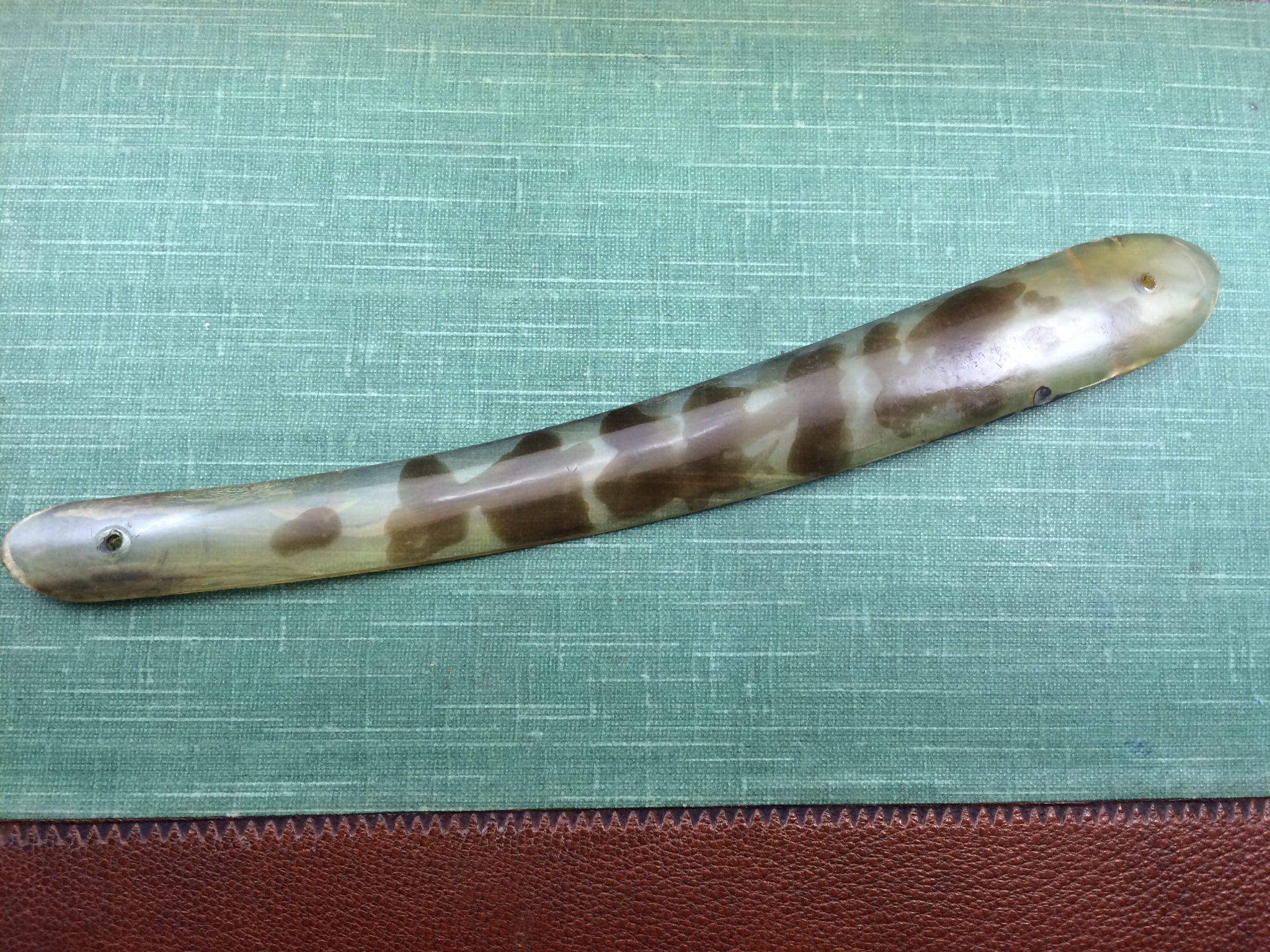Results 1 to 10 of 10
 19Likes
19Likes
Thread: Horn or tortoise?
-
11-26-2014, 08:20 PM #1
 Horn or tortoise?
Horn or tortoise?
I am inclined to think these scales are dyed horn but just want to make sure. What say you?
-
11-26-2014, 08:24 PM #2

definitely look like dyed horn to me I have had similar coloured scales & it sanded off when cleaning them up
Saved,
to shave another day.
-
11-26-2014, 08:24 PM #3

I think they are dyed horn too. Nice looking scales. Shouldn't have to do much to them either. I have sanded some that lost some of the coloring after sanding.
-
11-26-2014, 08:30 PM #4

yeh don't sand only polish if you want to keep the colouring
Saved,
to shave another day.
-
11-27-2014, 01:47 AM #5

It's definitely dyed horn.
And while I haven't had a chance to get a tutorial posted up, I've been experimenting with re-dyeing old horn scales.
It's easy, and very doable.
Modern, permanent hair dye works great!
This was originally pure honey-horn. No coloration at all:

I've got a couple more experiments to do (darker dye, this one was 'medium brown' and I'd like to try dark brown and black), and I'll make a post all about it as well as a new trick for fixing horn scales where the razor won't seat properly.Last edited by Voidmonster; 11-27-2014 at 01:50 AM.
-Zak Jarvis. Writer. Artist. Bon vivant.
-
11-27-2014, 10:54 PM #6

will have to keep an eye out for that for sure
Saved,
to shave another day.
-
11-27-2014, 11:51 PM #7

yes please do make a tutorial. that would be very interesting/useful.
-
11-28-2014, 01:02 AM #8

i remember reading an article about how they originally did & it seemed pretty toxic what hey used
Saved,
to shave another day.
-
11-28-2014, 03:06 AM #9

Yeah, I looked up the old method and filled in the big check mark next to NOPE.
There's a pretty good file on all manner of horn work here.
I started investigating hair dye because the razors that I wanted to refresh the patterning on are assembled and it would be a larger than normal investment of time and energy to take them apart (they have pewter clasped ends that are hammered and shaped into place rather than just pins), boil the scales until the fibers open up, and then find the relatively toxic stuff used to dye them.-Zak Jarvis. Writer. Artist. Bon vivant.
-
11-28-2014, 05:49 PM #10Senior Member



- Join Date
- Apr 2008
- Location
- Essex, UK
- Posts
- 3,816
Thanked: 3164
Painting horn is a centuries old art practiced by the Worshipful Guild of Horners. In the 17th century tortoiseshell (from a marine turtle, not a land going tortoise) was in such great demand, that many ways were devised to copy it using horn. But before this horn was used for knife handles for its own virtues, but so invasive was the tortoiseshell fakeries that we find 18th century and earlier directories listing makers of 'spotted' or 'speckled' hafted blades - mock tortoiseshell knifes.
Both are known as natural thermoplastics, both being laminar forms of keratin, similar to what our hair and fingernails are made from. Similarly, whatever dyes our hair and nails will dye horn, and back in the day it was found that more or less a lot of the dyes used for cloth worked too.
The secret was to dye them in the unfinished state - so the endings of the fibres could conduct the chemicals along them, then polish them up. That does not involve boiling, btw - a simple rough sanding suffices.
A lot of the times the colouration was applied to the inner surface (it was applied to the outer surface too), so in the previous example sanding the front would have no impact on the pattern other than making it harder to see through the hazed, frosted scales, but it leaps back into life one the surface is repolished.
Some of the processes used were not that toxic - mulberries were used for one recipe and boiling in raspberries gave horn a pleasingly pink blond or dyed colour. However the preliminary jobs were a source for injury involving heated metal and oil and tallow - the horn, whether it be for specs, combs or scales was all subject to being heated, spit, pressed in a hot vice with molten tallow, scraped for surface imperfections then sent onto the dyer of scalemaker or comb maker.
Here are some posts I made on this very forum listing the more toxic processes used - sadly forgotten by all but myself these days, it seems:
post #3
post #2
post #2
No doubt this will be forgotten in an equally short amount of time.
The horn did not even have to be natural blond - it could be bleached and died yellow in an alum bath. Dark spots did not matter - the whole of the horn could be made black, then selectively ligthtened.
As for todays hair colourings being safe that is very obviously the case, but those guys back in the day couldn't pop out to the drugstore and purchase a few bottles of Harmony or L'Oreal - whether they were worth it or not.
If we had to reproduce hairdyes from today then I expect we would be dealing with some pretty hazardous chemicals ourselves...
Regards,
NeilLast edited by Neil Miller; 11-28-2014 at 07:18 PM. Reason: correcting some typos
-
The Following 4 Users Say Thank You to Neil Miller For This Useful Post:
Baxxer (11-28-2014), Euclid440 (11-28-2014), rolodave (11-28-2014), Voidmonster (11-28-2014)



 LinkBack URL
LinkBack URL About LinkBacks
About LinkBacks






 Reply With Quote
Reply With Quote

